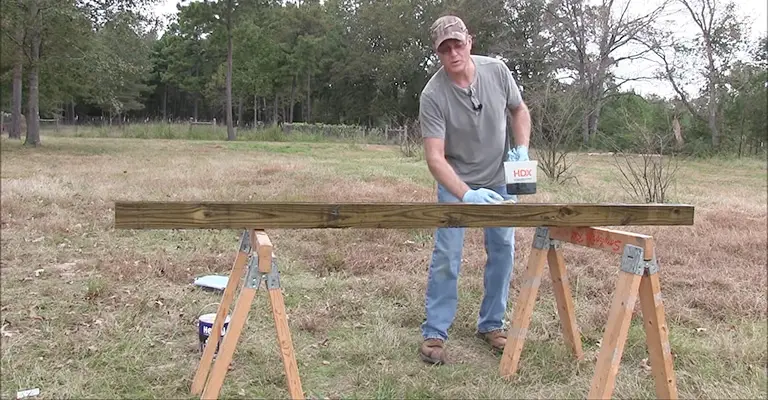Wood is a versatile and widely used material in various construction and outdoor projects.
However, when wood comes into direct contact with the ground, it becomes susceptible to decay, rot, and insect damage due to moisture and other environmental factors.
To ensure the longevity and structural integrity of wood in ground contact applications such as decks, fences, garden beds, and posts, it is crucial to apply appropriate treatment methods.
How To Treat Wood For Ground Contact?
You may have a problem with what is called ground contact. A deck above grade, porch railings, or decks that rest directly on soil or other wet surfaces is an example of this type of wood.
These timbers expand and contract more than normal outdoor timbers because moisture seeps into them.
The moisture in wood will cause it to rot and decay, but thankfully for us, it can be treated to protect it from rain and sunlight, extending its life.
To treat wood for ground contact, soak it in wood preservative for 20 minutes on the part that will contact the ground.
A thick layer of the same wood preservative should then be applied to the wood part. Put the wood in the ground after it has dried overnight.
It is not difficult to protect wood from the elements. The preparation of wood for outdoor use can be done in a number of ways.
However, when it comes to preparing wood for ground contact, there are a lot more considerations to keep in mind, and protecting wood properly from rotting is a whole lot more challenging.
Treating Wood For Ground Contact With Wood Preservative
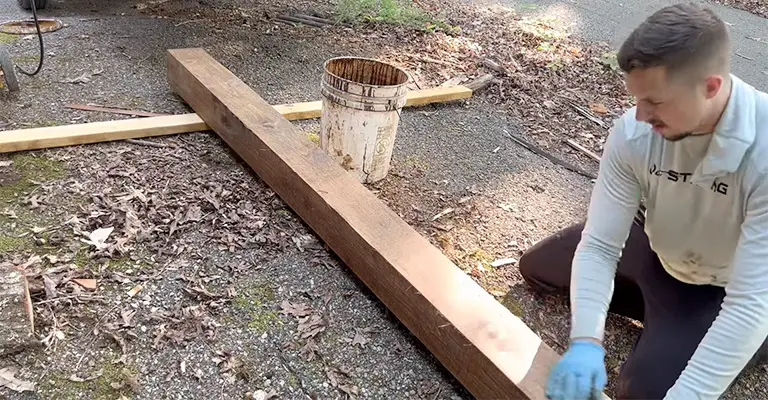
If you expect to use a wood preservative that comes in contact with the ground, then it should contain copper naphthenate and meet the AWPA (American Wood Protection Association) Standard.
A common and effective method for preserving wood, this is probably the most commonly used. If you don’t have a bucket, you can use a pressure sprayer to soak your wood with the preservative.
In order to preserve wood that will be in contact with the ground, you need to soak it thoroughly in wood preservative.
The wood preservative can either be poured into a bucket or sprayed onto the necessary parts of the wood using a sprayer.
The most important thing is to completely soak the wood in the preservative for at least 15 minutes, regardless of the method you use.
Next, apply a thick coat of preservative to the wood that will be in contact with the ground with a paintbrush. The wood should be left to dry overnight before it is placed on the ground.
You should now be able to ground contact your wood, but keep in mind, there is no way to prevent rot and decay forever, so the wood will eventually decay no matter how well you applied the preservative.
The preservative will now protect it from moisture, so it will take years before it starts to rot.
How Long Does Ground Contact Wood Last?
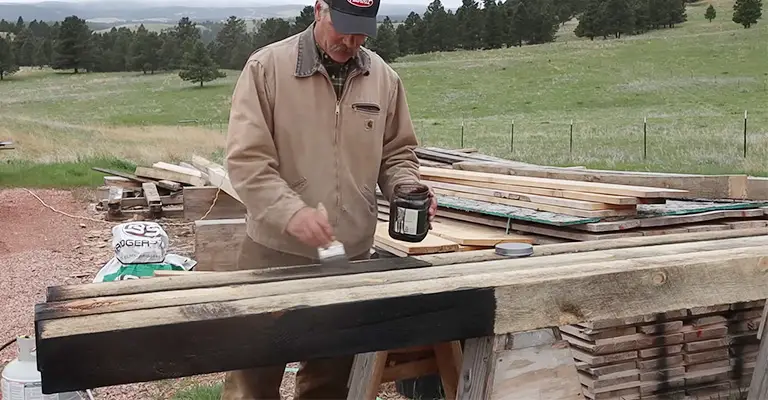
From the beginning of this article, this was probably your biggest concern. This is a difficult question to answer straight-forwardly.
Wood that has been pressure-treated and treated with wood preservative will last longer in the ground depending on a variety of factors.
These include factors such as the amount of moisture in the ground, what kind and how many insects live there, how extreme the temperature changes are, etc.
It depends on the location, the type, and how well the wood was preserved before burial that determines how long ground-contact wood lasts.
The wood will generally not last as long if the ground is very moist or if the surrounding temperature changes frequently.
A properly treated piece of wood can usually live for at least 8 years in the ground, although predicting how long it will last is impossible. It is possible for most posts to last much longer, especially if they are cast in concrete.
Choosing the Right Kind of Wood for Ground Contact
If you choose the right kind of wood, you can easily quadruple your project’s lifespan. Just prepare the wood for ground contact and you’re good to go.
The first step to creating something durable is to choose the right type of wood. This is especially true if your project is exposed to contact or partially buried.
First off, if you’re going to have the wood in contact with the ground, I’d highly recommend using pressure-treated wood.
The ICC (International Code Commission) or the AWPA (American Wood Protection Association) only treat pressure-treated wood in accordance with their standards.
You can use either UC 4A or UC 4B treated lumber. There are labels on the wood that indicate its use below ground.
In spite of the fact that this lumber is designated as below-ground use, it still needs to be prepared for contact with the ground by treating it with wood preservative according to the instructions above. This is especially true if the wood has been cut before being used!
Several types of wood are particularly suitable for underground use. There are different types of wood that are suitable for different places.
Cypress Wood
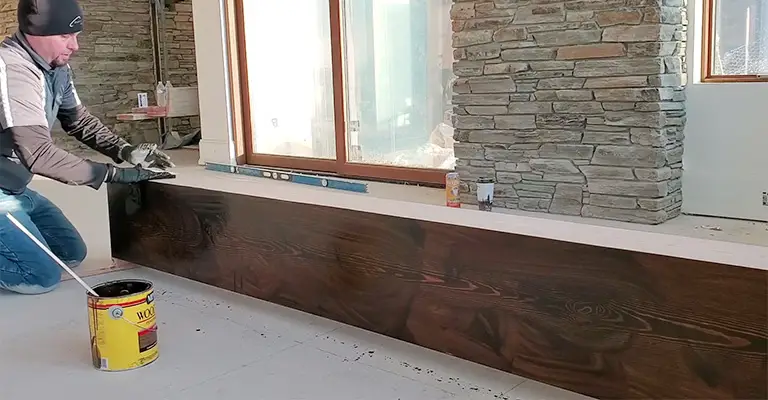
For underground use, cypress wood is the best choice. Below-ground applications benefit from its natural moisture resistance.
You can choose cypress wood if you are not sure what kind to choose. This one is a no-brainer!
White Cedar
Those who live in swampy or wet environments will probably benefit most from white cedar.
Natural resistance to fungus of all kinds, as well as natural resistance to rot, make cedar a perfect wood for outdoor construction. Make sure the white cedar you purchase is pressure treated and either labeled UC 4A or 4B!
Redwood
There are some examples of redwoods living up to 100 years old, making them one of the oldest woods on the planet.
Thus, it should not come as a surprise that it is one of the toughest wood types, showing its ability to withstand conditions that would otherwise cause most other woods to crumble.
In terms of ground contact effectiveness, redwood rivals even pressure-treated wood when it comes to being one of the best woods to use.
Pressure-Treated Wood
There is a lot of talk about pressure-treated wood, but what exactly does it mean?
Wood that has been pressure-treated has been treated with a range of chemicals and then placed into a pressurized chamber so that the chemicals bond with the fibers of the wood.
The rot, mold, insect infestation, moisture damage, abrasion, and general decay of pressure-treated wood are highly resistant.
Reasons for Prolonged Wood and Ground Contact
To prevent rot and general degradation, wood would need to be treated in many instances when it is in direct contact with the ground. How do they work?
These are some situations where wood would be placed directly on the ground and their reasons behind it.
Garden Boxes
There has been a surge in popularity in the use of garden boxes in recent years, despite being one of the least thought of examples of ground contact wood.
Many newcomers overlook the need to treat the wood used to construct their garden boxes for ground contact as a result of discovering the benefits of micro-farming and vegetable gardening in general.
Even though it does not affect the flowers or vegetables inside the box, it can create an unsightly sight and it can become an annoyance when your beautiful garden box rots away from microbes or insects.
For this reason, it is extremely important to treat the wood before assembling your garden box. Basically, you save a lot of time and money later on.
Sill Plates
It is common for sill plates to be the first pieces of wood which are used as structural members in rural or suburban areas. How does a sill plate work?
To connect the rest of the house to the foundation, this piece of wood is essentially thick and horizontal.
As the wood pieces encounter soil and concrete, a variety of microorganisms become attracted to and housed in these surfaces.
Fence Pickets
When we think of wood that comes in direct contact with the ground, we often think of fence pickets, which are among the most commonly treated woods.
The reason for this is that picketed fences are so common in small towns (for those in big cities, you are excused).
It’s important to protect them against external forces and ground rot since they’re often used to mark property boundaries far from anything to protect them.
Structural Posts
A structural post serves the same function as a deck post, but they are often larger and their failure can have much more serious consequences.
The purpose of structural posts is to support structures such as verandas, roofing systems, and non-load-bearing walls. Due to their robustness, they are usually made from wood, making them highly resistant to decay, but not immune.
A particular focus should be placed on monitoring, maintaining, and treating these posts frequently to combat insect infestations, rot, and general decay.
Deck Posts
A deck post elevates a deck above the ground and can be used to relax, barbecue, or even sit in a hot tub from a viewing platform!
Despite being unnoticed by most of us, these posts reinforce our decks and keep them structurally sound.
In other words, if they are not prepared and maintained throughout their lifespan, they will always be at risk for rot and decay.
How Do You Make Wood Last Longer In The Ground?
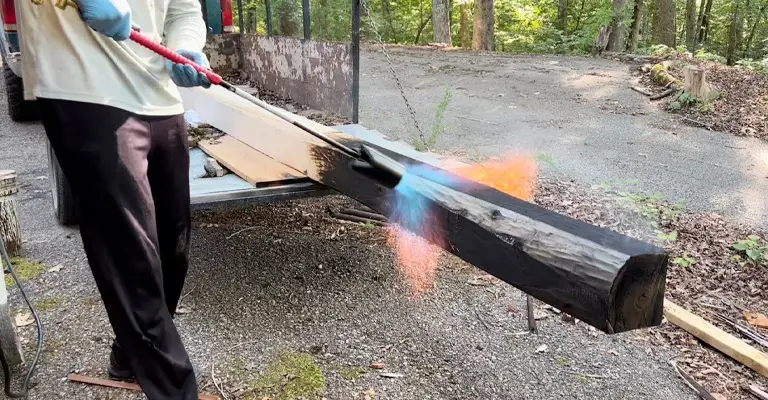
There is no shortcut to making wood last longer. It must be protected with a good wood preservative and sealer. In the past, ground contact lumber was treated with diesel oil.
About a foot above the ground, the oil would be applied. It is no longer recommended to use diesel oil to treat ground contact lumber due to health and environmental concerns.
Groundwater may become contaminated, and ecosystems may be harmed by diesel oil’s harmful substances and pollutants.
Pressure-treating ground contact lumber is usually the industrial option. Preservatives are used in pressure-treated timber. By applying pressure, the preservatives penetrate deep into the wood grain.
Use of treated lumber as ground contact lumber will not result in any rot problems. Though this type of lumber has some advantages, it also has some disadvantages.
It is common for pressure-treated lumber to have a high moisture content, for instance. In other words, as this lumber dries, you will run into split warp, check, and twist challenges.
Green tints are typically associated with pressure-treated wood that may be undesirable if a natural appearance is desired.
Why Does Soil Contact Cause Wood to Rot?
Since wood is often used in household furnishings and homes, it has the natural tendency to decompose after it’s stripped or cut from its original tree form.
When wood is cut from a tree and fashioned into something else, how does it decompose?
The factors that contribute to the slow degradation of wood include microbes, density, moisture exposure, insect infestation, and plant life taking up residence within ground-planted wood.
Keeping furniture indoors and devoid of moisture is another reason why wood that has been formed into furniture doesn’t degrade.
During its contact with soil, wood may come into contact with as many as five million microbes, some of which nibble on or invest in its fibers, which eventually leads to wood degrading.
The wood starts to break down into chunky pieces when it is attacked by brown rot, which attacks the cellulose in the wood.
A spongy, off-white texture is the characteristic of wood infected with white rot, although it has the same effect on wood.
If you don’t prepare your wood properly before it goes into the ground, you’ll be able to protect it from rot and prevent it from spreading as well.
FAQs
How Long Can Ground Contact Wood Last?
The majority of wood in constant contact with soil is only designed to last about ten years, whereas we would like our fences and garden boxes to last a lifetime.
Before inserting your wood into the ground, you should treat it so that its lifespan and protection can be extended.
What Lumber Is Required for Ground or Concrete Contact?
Pressure-treated wood is by far the best choice for this application, regardless of the fact that many wood species are naturally resistant to ground contact, such as redwood and cypress.
You can prevent mold and microbes from damaging your workpiece by using pressure-treated wood. Pressure-treated wood is basically infused with chemicals that preserve the wood.
What Is the Best Pressure-treated Wood for Ground Contact?
Look for pressure-treated wood with the marking UC4B or UC4A if you’re looking for the best ground contact wood. How come?
These markers indicate boards that are rated for use below ground and highly resistant to decay and rot.
Final Words
It is possible for wood that is in contact with the ground to rot. Keep your deck and fence in good condition by treating the wood to prevent rot.
The use of ground contact preservatives is one method of protecting wood against ground contact, though there are many other kinds of chemicals used to preserve wood.

